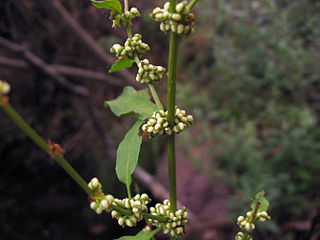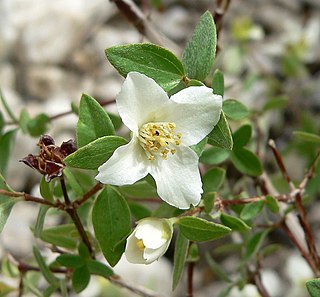
The docks and sorrels, genus Rumex, are a genus of about 200 species of annual, biennial, and perennial herbs in the buckwheat family, Polygonaceae. Members of this genus are very common perennial herbs with a native almost worldwide distribution, and introduced species growing in the few places where the genus is not native.

Rumex crispus, the curly dock, curled dock or yellow dock, is a perennial flowering plant in the family Polygonaceae, native to Europe and Western Asia.

Rumex obtusifolius, commonly known as bitter dock, broad-leaved dock, bluntleaf dock, dock leaf or butter dock, is a perennial plant in the family Polygonaceae. It is native to Europe, but is found on all temperate continents. It is a highly invasive species in some zones, resulting from its abundant seed dispersal, adaptability to reproduce, aggressive roots, ability to tolerate extreme climates, and hardiness.

Rumex acetosella, commonly known as red sorrel, sheep's sorrel, field sorrel and sour weed, is a species of flowering plant in the buckwheat family Polygonaceae. Native to Eurasia and the British Isles, the plant and its subspecies are common perennial weeds. It has green arrowhead-shaped leaves and red-tinted deeply ridged stems, and it sprouts from an aggressive and spreading rhizome. The flowers emerge from a tall, upright stem. Female flowers are maroon in color.

Rumex conglomeratus, known as clustered dock and sharp dock, is a plant of the family Polygonaceae. It is an annual or biennial plant growing up to 100 cm high. A native of Europe, Asia and North Africa, it has also been introduced into North America.

Allium validum is a species of flowering plant commonly called swamp onion, wild onion, Pacific onion, or Pacific mountain onion. It is native to the Cascade Range, to the Sierra Nevada, the Rocky Mountains, and other high-elevation regions in California, Oregon, Washington, Nevada, Idaho and British Columbia. It is a perennial herb and grows in swampy meadows at medium and high elevations.

Sarracenia leucophylla, also known as the crimson pitcherplant, purple trumpet-leaf or white pitcherplant, is a carnivorous plant in the genus Sarracenia.

Salix lasiolepis is a species of willow native to western North America.

Sambucus racemosa is a species of elderberry known by the common names red elderberry and red-berried elder.

Blitum californicum is a species of flowering plant in the amaranth family known by the common names California goosefoot and (ambiguously) "Indian lettuce".

Philadelphus microphyllus is a species of Philadelphus known by the common names littleleaf mock-orange or desert syringa. It is native to northern Mexico and the southwestern quadrant of the United States as far north as Wyoming, where it grows in scrub and brush habitat in foothills and mountains, often in very rocky areas, sometimes anchoring itself in rock cracks and crevices.
Rumex dentatus is a species of flowering plant in the knotweed family known by the common names toothed dock and Aegean dock. It is native to parts of Eurasia and North Africa, and it is widely known elsewhere as an introduced species. It grows in disturbed habitat, often in moist areas, such as lakeshores and the edges of cultivated fields. It is an annual or biennial herb producing a slender, erect stem up to 70 or 80 centimeters in maximum height. The leaves are lance-shaped to oval with slightly wavy edges, growing to a maximum length around 12 centimeters. The inflorescence is an interrupted series of clusters of flowers, with 10 to 20 flowers per cluster and each flower hanging on a pedicel. Each flower has usually six tepals, the 3 inner of which are edged with spinelike teeth and have tubercles at their centers.

Rumex pulcher is a species of flowering plant in the knotweed family known by the common name fiddle dock. It is native to Eurasia and North Africa and it can be found elsewhere, including parts of North America, as an introduced species and a roadside weed. Europe. It is quite variable in appearance, and some authorities divide it into several subspecies that are more or less distinguishable. In general, it is a perennial herb producing a slender, erect stem from a thick taproot, approaching 70 centimeters in maximum height. The top of the plant may bend, especially as the fruit develops. The leaves are up to 10 or 15 centimeters long and variable in shape, though often oblong with a narrow middle in the rough shape of a fiddle. The inflorescence is made up of many branches, each an interrupted series of clusters of flowers with up to 20 in each cluster, each flower hanging from a pedicel. The flower has usually six tepals, the inner three of which are edged with teeth and have tubercles at their centers.

Rumex salicifolius is a species of flowering perennial plant in the knotweed family known by the common names willow dock and willow-leaved dock. It is native to much of western North America, and more specifically, in southern and central parts of California, and some parts of Arizona and Nevada. It can also be found in parts of Europe as an introduced species and a roadside weed. It is an extremely variable plant which is generally divided into many varieties, some of which may actually be specimens of other species.

Rumex venosus is a species of flowering plant in the knotweed family known by the common names veiny dock, winged dock, sand dock, and wild-begonia. While not of any particular agricultural use, its cousins rhubarb and buckwheat are. It is native to central and western North America, from southern parts of the Canadian prairies, through to Mexico.

Scleranthus annuus is a species of flowering plant in the family Caryophyllaceae known by the common names German knotweed and annual knawel. It is native to Europe, Asia, and North Africa, and it is known throughout the rest of the temperate world as an introduced species and a common weed. It grows in many types of habitat, often in disturbed areas.

Senecio hydrophiloides is a species of flowering plant in the aster family known by the common names tall groundsel and sweet marsh ragwort. It is native to western North America from British Columbia and Alberta to northern California to Utah, where it grows in wet meadows and similar habitat. It is a biennial or perennial herb producing a single erect stem or a cluster of a few stems which may exceed one meter in maximum height. The plants are green to red in color and usually without hairs, but new growth can be woolly. The leaves are lance-shaped to oval with toothed edges, the blades up to 25 centimeters long and borne on long winged petioles. The leaves are firm and sometimes a bit fleshy. The inflorescence is a loose or dense cluster of up to 30 or more flower heads lined with black-tipped phyllaries. They contain many yellowish disc florets at the center and often have some yellow ray florets, though these are sometimes absent. Senecio Hydrophiloides can cause Dermatitis.

Drymocallis glandulosa, known by the common name sticky cinquefoil and formerly as Potentilla glandulosa, is a plant species in the family Rosaceae.

Rumex sanguineus, commonly known as wood dock, bloody dock or red-veined dock, is a perennial flowering plant species in the family Polygonaceae. Rumex sanguineus is a dicot and can be observed in Europe with at least two varieties.

Rumex occidentalis is a flowering plant species belonging to the family Polygonaceae. Commonly known as western dock, Rumex occidentalis can be found in parts of Western North America.



















